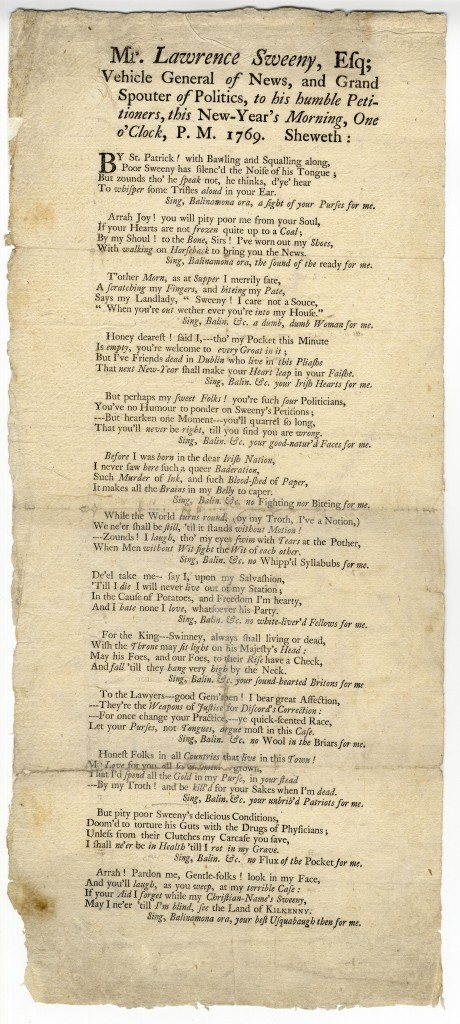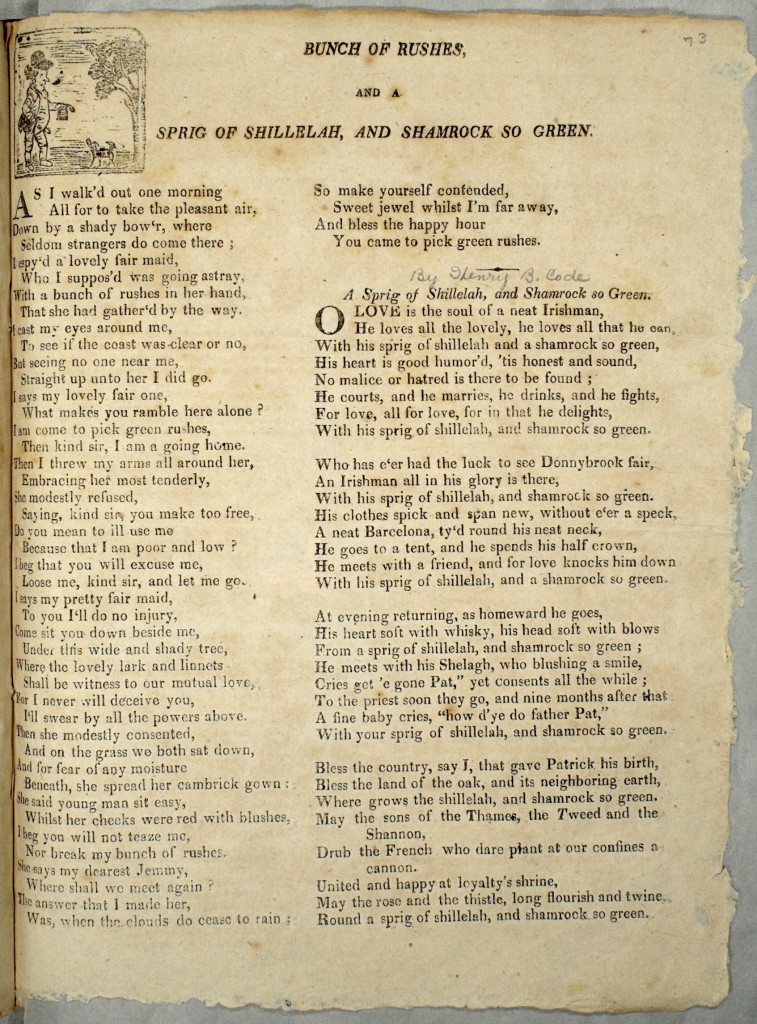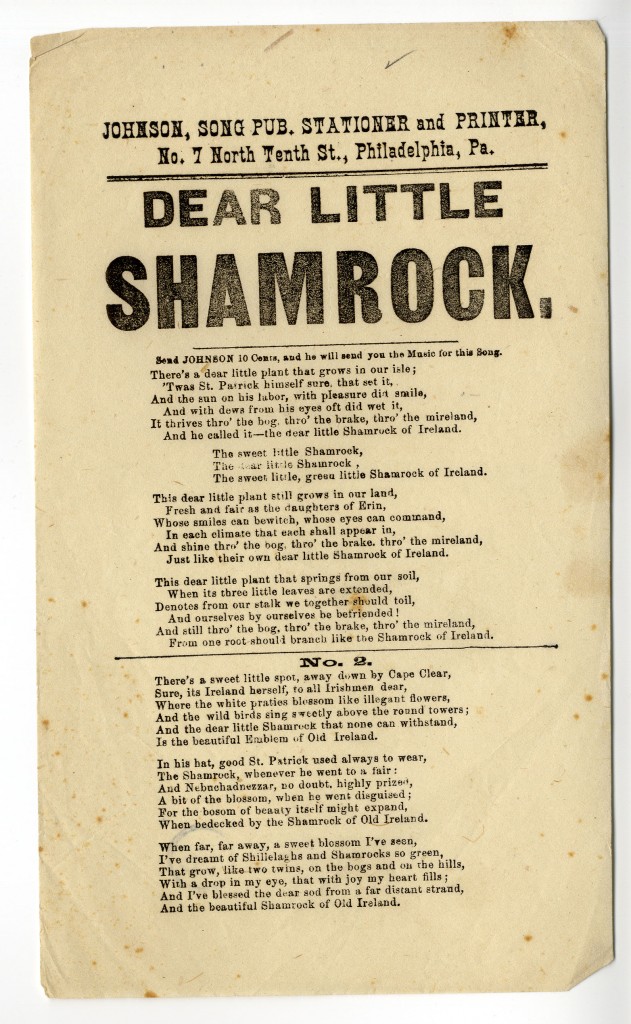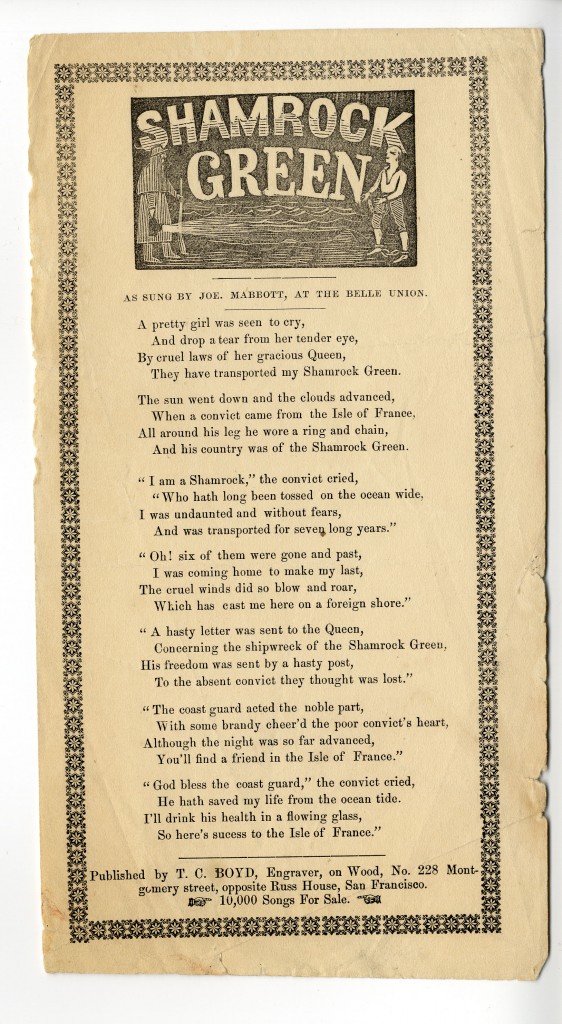This post will present approximately one hundred years of Irish ballads contained within the Society’s collections. The first is a fascinating 1769 broadside containing a New Year’s address by Ireland native Lawrence Sweeney (-1770), a popular figure in New York City journalism in the 1760s. Sweeney is one of the first identifiable Irish-American voices. He was so well-known that he made an appearance in AAS founder Isaiah Thomas’s History of Printing in America for his assistance in the distribution of the Constitutional Courant, a seditious newspaper printed during the Stamp Act crisis of 1765.[i] Sweeney’s authored text displays an American interest in Ireland and the emerging Irish-American experience (with its share of satire and sadness). The ballad concludes, “Arrah! Pardon me, Gentle-folks! Look in my Face/ And you’ll laugh, as you weep, at my terrible Case:/ If your Aid I forget while my Christian-Name’s Sweeny,/ May I ne’er ‘till I’m blind, see the Land of KILKENNY./ Sing, Balinamona o a, your best Usquebaugh then for me.”
 click here to enlarge in GIGI
click here to enlarge in GIGI
The ballads transitioned from the Sweeney-authored (i.e. Vehicle General of News and Grand Spouter of Politics) to ones of Irish and British origin that were reprinted in the United States. The first edition of Paddy’s Resource, a collection of political ballads and Irish national songs (with toasts and sentiments), was first printed in 1796 in Philadelphia. AAS owns a later edition printed in New York in 1798. Contained within it is “Teague and Pat” set to the tune of “Patrick’s Day in the Morning.” It’s a song that looks forward to expanded freedom: “The time is approaching, we yet WILL BE FREE;/ When Peace and good will every bosom will fill,/ Then Paddy’s Resource shall have its free course-/ On Patricks’ day in the morning.”
 click here for the title page and contents enlarged in GIGI
click here for the title page and contents enlarged in GIGI
A search of Irish songs and music of the Society’s collection also provides several from the Isaiah Thomas collection of broadside ballads, presented to the Society in August 1814. AAS owns three copies of one broadside ballad, “A Sprig of Shillelah, and Shamrock so Green,” by Irish songwriter and dramatist Henry Brereton Code (-1830) and printed by Nathaniel Coverly in Boston. (AAS also has an 1830s copy sold by L. Deming which is paired with “O’er the hills and far away.”) The ballad is one which represents the “love” theme in Irish music (this theme meaning to include love of country and/or love of a girl). The song starts, “O LOVE is the soul of a neat Irishman,/ He loves all the lovely, he loves all that he can,/ With his sprig of shillelagh and a shamrock so green…”
 click here to view all three copies of this ballad broadside
click here to view all three copies of this ballad broadside
Other Irish songs are incorporated into the Society’s ephemera ballad collection. One with an illustrated ornamental border, “Paddy on the Canal,” printed and published by H. De Marsan, is a song of an Irish emigrant and his path to becoming a canal construction worker after leaving his family. The author learns the “art of canalling” – and he “…learned to be very handy, although I was not very tall,/ I could handle the sprig of shillelagh, with the best man on the canal.”
 click here to view an enlargement in GIGI
click here to view an enlargement in GIGI
Other ballads were reproduced by specific song publishers, stationers, and printers such as John H. Johnson in North Tenth Street in Philadelphia. “Dear Little Shamrock” by Irish writer, dramatist, and actor Andrew Cherry (1762-1812) has two songs and a note that if you send Johnson “10 Cents, he will send you the Music for this Song.” “No. 2” on the sheet may be the most St. Patrick’s Day-appropriate for a modern audience as it invokes the beautiful “Emblem of Old Ireland.”
 click here to view an enlargement in GIGI
click here to view an enlargement in GIGI
Songs and music about Ireland, though mostly represented in the Society’s Boston, New York, and Philadelphia imprints, were printed on the West Coast of the United States as well. The Bella Union, which originally opened as a gambling house, also hosted minstrel shows and varied types of entertainment.[ii] Theodore C. Boyd, the publisher and engraver of Shamrock Green, printed this ballad in 1862 which was sung by Joe. Mabbott at the Bella Union. The text describes an Irish exile/convict – Shamrock Green – who drinks to his rescue.
 click here to view an enlargement in GIGI
click here to view an enlargement in GIGI
Irish music is a staple of St. Patrick’s Day; we have offered here print-size copies of songs to pair with a pint-size portion of your choosing. Feel free to use, share, sing, or study in your celebrations.
[i] Isaiah Thomas and Benjamin F. Thomas, The History of Printing in America: With a Biography of Printers, and an Account of Newspapers, Vol. 2 (Albany, N.Y: J. Munsell, printer, 1874), p 130.
[ii] Jeremy Agnew, Entertainment in the Old West: Theater, Music, Circuses, Medicine Shows, Prizefighting and Other Popular Amusements (Jefferson, N.C: McFarland & Co., 2011), p 83.
